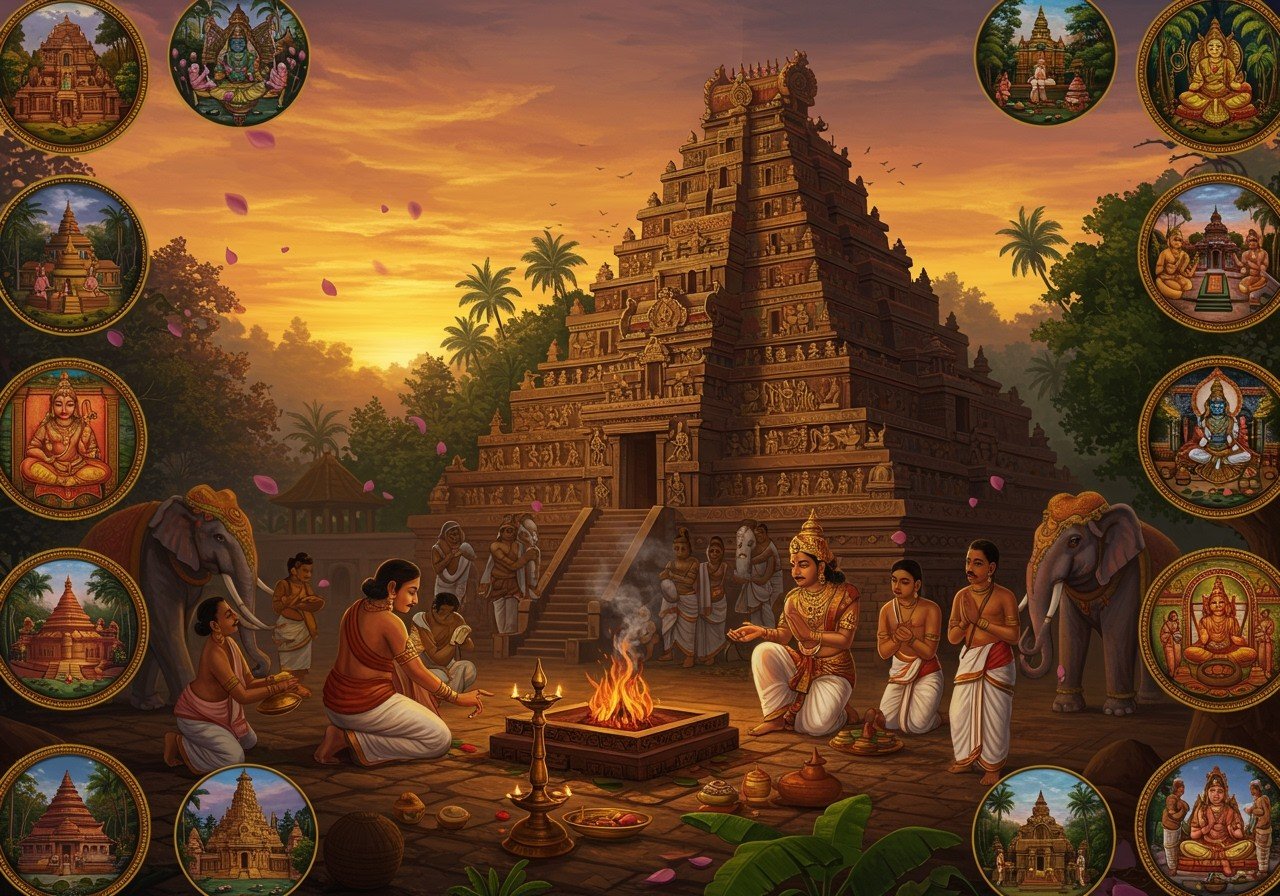
The Chera Dynasty, a prominent kingdom in ancient South India, thrived between the 3rd century BCE and the 12th century CE. Alongside their significant contributions to trade, literature, and culture, the Cheras possessed a rich spiritual and religious landscape. This article delves into the religious and spiritual beliefs of the Chera Dynasty, examining their deities, temples, unique rituals, and the lasting impact on South Indian culture.
Historical Overview of the Chera Dynasty
The Chera Dynasty held sway over regions that now comprise parts of Kerala and Tamil Nadu. Known for their robust trade connections with the Romans and other ancient civilizations, the Cheras flourished under notable rulers like Senguttuvan, who championed culture, literature, and religious practices. Neighboring kingdoms, including the Cholas and Pandyas, exerted influence on Chera religious customs. The Chera people had diverse religious beliefs, including ancestral worship and deity worship in open shrines and under trees. They also practiced animism and had significant influences from Jainism, Hinduism, and Buddhism during different periods of their reign. Indigenous Dravidian traditions intertwined with Vedic practices introduced through northern migrations, creating a unique spiritual blend. Tamil Sangam literature played a vital role in preserving and disseminating Chera religious and cultural beliefs.
Deities Revered by the Cheras
The Chera Dynasty embraced a diverse pantheon of deities, reflecting a fusion of indigenous traditions and Vedic influences. Bhagavati, a manifestation of the Mother Goddess, held a prominent position. Murugan (Kartikeya), deeply rooted in Tamil traditions and associated with warfare, received widespread reverence. The worship of Vishnu and Shiva further underscored the integration of broader Hindu influences. Local deities like Kuttichathan and Yakshis retained their significance within folk traditions. Jainism and Buddhism also found adherents during specific periods, showcasing the syncretic nature of Chera religious practices, which harmoniously combined various belief systems.
Chera Dynasty Temples: Architectural and Spiritual Centers
Temples constituted the heart of Chera religious life. Characterized by distinct architectural styles, including the use of granite and intricate carvings, these temples served as vital hubs for worship, education, cultural activities, and social gatherings. Prominent temples from this era, such as the Thirunelli Temple and Sree Padmanabhaswamy Temple, stand as testaments to the Cheras’ architectural prowess and spiritual devotion. Festivals like Pooram fostered community bonds and reinforced shared religious experiences. Temple priests, artisans, and custodians played essential roles in upholding religious traditions. Royal patronage from Chera rulers facilitated the dissemination of their religious beliefs. Today, ongoing preservation efforts strive to safeguard these ancient temples for future generations.
Religious Practices and Rituals of the Chera Dynasty
Chera religious practices encompassed daily worship rituals involving offerings of flowers, fruits, and lamps. Major festivals like Onam, deeply embedded in Chera traditions, continue to be celebrated with fervor. Pilgrimage sites within the kingdom held profound significance for devotees seeking spiritual solace. Astrology played a notable role in spiritual life, with rituals like Thulabharam carrying special weight. Martial traditions were interwoven with religious worship, particularly in the veneration of Murugan.
Influence of Literature and Arts on Chera Spirituality
Literature and the arts served as powerful mediums for expressing Chera spirituality. Tamil Sangam literature meticulously documented religious beliefs, practices, and deities, offering invaluable insights into the spiritual landscape of the time. Influential poets like Ilango Adigal, whose epic ‘Silappatikaram’ illuminates Chera religious life, contributed significantly to the literary heritage. Dance forms like Kathakali and Theyyam vividly portrayed religious stories and myths, while temple architecture inspired classical Tamil art and sculpture. Music, notably Carnatic music, played a vital role in religious worship and rituals.
Legacy and Contemporary Relevance of Chera Spirituality
The religious legacy of the Chera Dynasty continues to resonate in modern practices. Chera deities remain objects of veneration in Kerala’s religious landscape. Ancient Chera temples serve as important pilgrimage destinations, drawing devotees from far and wide. Festivals like Onam, while having evolved over time, retain their core spiritual elements. Chera-era literature is studied in both academic and spiritual contexts, ensuring its continued relevance. Contemporary Hindu rituals in South India reflect the enduring influence of Chera religious practices. Modern temple management initiatives endeavor to preserve and transmit ancient traditions to future generations.
Poojn.in: Your Source for Cultural and Religious Products
Poojn.in, India’s leading online store for cultural goods and services, offers a wide array of products to support your spiritual practices. Whether you seek puja items, religious artifacts, or resources for traditional ceremonies, Poojn.in provides a convenient and reliable platform to connect with your heritage.
-
Explore our collection of puja items: https://www.poojn.in/product/11870/mangalam-camphor-butter-paper-400g-approx-200-pieces Discover a wide variety of high-quality puja essentials, including lamps, incense, and offerings, to enhance your daily worship.
-
Discover authentic religious artifacts: https://www.poojn.in/product/10393/sai-baba-hand-crafted-pure-marble-dust-sculpture-idol-murti-8-inch-murti Find beautifully crafted statues, idols, and other religious artifacts to create a sacred space in your home.
-
Learn about traditional ceremonies: https://www.poojn.in/post/17230/bhoganandishwara-temple-rituals-and-traditions-experiencing-the-divine Delve into the rich history and significance of various Hindu ceremonies and rituals through our informative blog posts.
Conclusion
The Chera Dynasty’s profound religious and spiritual heritage has indelibly shaped South Indian culture and traditions. Their unique synthesis of Dravidian and Vedic practices, diverse pantheon of deities, and magnificent architectural achievements continue to influence contemporary religious expressions. Chera temples remain vital centers of worship and cultural activity, while festivals like Onam perpetuate their enduring legacy. The impact of Chera literature and arts is evident in modern manifestations of spirituality. By honoring these ancient traditions, we preserve the spirit of the Chera Dynasty, forging a meaningful link between the past and the present.


